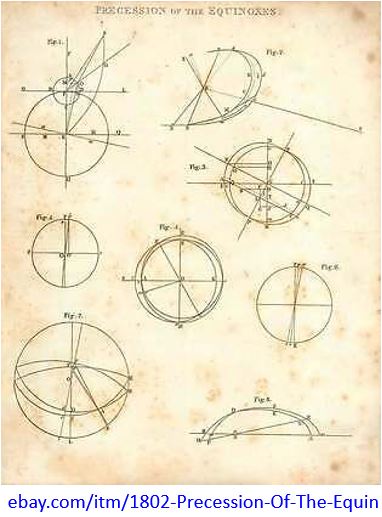
There are several ways to calculate the attributes (parameters) of precession from the astronomical data of Almagest.
This subsection seems to be a short digression, but I recommend reading it not because it is short but because it is relevant for what follows.
Hipparchus measured the length of the tropical year (solar year) as 365 1/4 days – 1/300 days or expressed others 365 days 5 hours 55 minutes (rounded, slightly shorter than the well-known 365 1/4 days).
Today’s figure for the tropical year is ~365.24219 days, i.e., 365 days, five h 48 m 45s.
He measured the length of the sidereal year, 365 1/4 days + 1/144 days, i.e., 365 days 6 hours 10 minutes.
Today’s figure for the sidereal year is longer than the tropical year by 20 min 24.5 s, ~365.256360 days, i.e., 365 days 6 hours 9 m 9,54s.
The parameters of the precession can be calculated from these data.
The 15-minute per year time difference between the tropical and sidereal years lengths corresponds to 1 day in 96 years (24/0,25=96), and the cycle time is 96*365.25 = 35,064 years.
It means round 1°/97.4 years (96*365,25/360= 97.4) angular velocity. Both parameters are very much imprecise. Namely, according to today’s measurements, the difference between the length of the tropical and sidereal years is not about 15 minutes but about 20 minutes. The 20 minutes results in a rounded 72 years per degree instead of 97.4, making the cycle time of 25.920 years mentioned above. 72*360=25.920.)
However, astronomers say that we cannot be sure that Hipparchus was aware of the possibility of calculating the cycle time from tropical and sidereal years.
Based on the fixed star coordinates of Hipparchus and Ptolemy, the parameters of precession are calculated as follows:
Hipparchus’ measuring comes from 128BC (-127), and Ptolemy’s probably from 138AD.
According to Almagest, in the 265 years between these two measurements, the ecliptic longitudinal (short Ecl. long.) angular rotation of the fixed star SPICA was 2°40′ = 2.67°. Therefore 265/2.67 = 99.25 years/degree.
Calculated in this way, the angular velocity of precession is 1°/99.25 years, and the cycle time is 35,730 years (99.25*360=35,730).
Based on this latter calculation, the literature states that according to Ptolemy and the Almagest, the angular velocity of precession is at least 1°/100 years, with a cycle time maximum of 36.000 years.
This, like the above calculation, is a wildly inaccurate figure, too.
According to today's measurements: angular velocity: 1°/71.6 years, cycle time: 25,776 years. The ancient error is around 38%. However, it is also written in Almagest and generally accepted that 152 years elapsed between the measurements of Hipparchus and Timocharis and that Hipparchus determined an angular change of 2° Ecl. long. over this 152 years. A 2° precession angular change over 152 years corresponds to a precession angular velocity of 1°/76 years and a cycle time of 27,360 years. This is a much more accurate result than that of Ptolemy. It is also close to today's values given above. Despite this facts, the literature emphasises Ptolemy's cycle time of "up to 36,000 years" and generally ignores Hipparchus' much earlier and more accurate figure of 27,360 years! For me, it's very noticeable and disturbing that there is such a massive difference between the calculations based on the coordinates of Hipparchus and that of Ptolemy. This observation will soon become very important!
